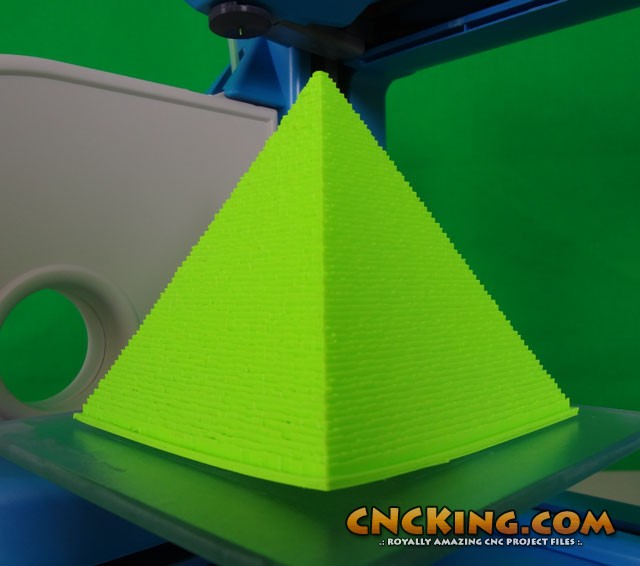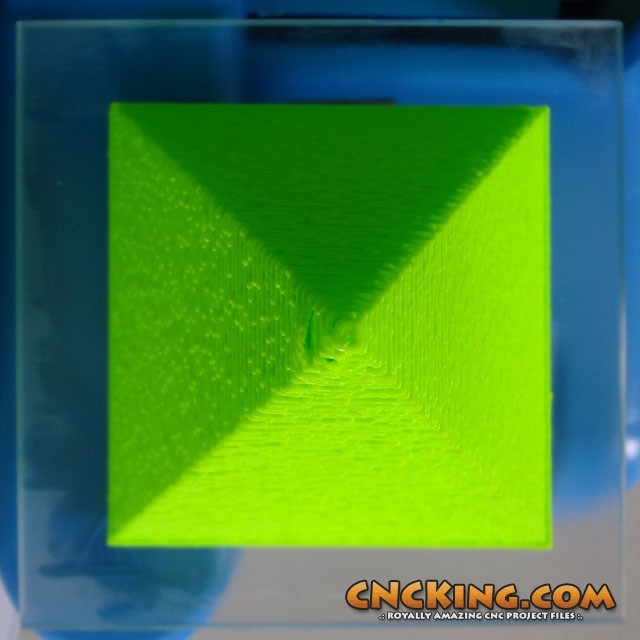3D Systems 2nd Generation Cube Initial Review
I’ve had the Cube for a few days now and figured-out most of the quirks involved with getting it to print a model. There are a few things that I like about the Cube and a few things I dislike.

This picture compares my 3D model with the output I’ve produced with the 3D Systems Cube on the left and my original 3D model render on the right. As you can see the resolution is pretty close – this is impressive as this is a two thousand dollar 3D printer, not a 30K 3D printer so I’m very happy with how close to the original the output was.
How long did it take to print this neon-green 4 inch square pyramid? 10 hours! That’s pretty close to the 9:30 hour estimate I was given by 3D Systems’ job control software. What I dislike about FDM though it can be easily applied to other 3D platforms as well is how LONG it takes to go from initial STL file to final output. I’ll be sharing the time lapse video of this print in a few days. Whether you have a zPrinter or a Replicator2 or FormLab – expect the model to take far more than a few minutes for anything substantial. It’s simply where 3D printing technology is at the moment.

This picture was taken in the middle of the night (2am) and before it was taken off the Cube 3D printer – you can still see the shiny glue surface! Look at the bottom and you’ll notice some bowing – what is odd is that the next day after shutting everything down, I noticed that the model had relaxed and became flat. I originally wanted to make this model 5 inches square (filling the entire platform for this test) but didn’t want to wait forever so I made it 4 inches square – I also had a few issues as discussed further down.
I’ve had this happen a few times with the model unsticking though – what happens is as the 3D model is printing, lifts-up with enough force to unstick itself from the platform. Once it becomes unstuck, it moves around and the whole model is junk. I was lucky in that this one managed to form itself perfectly on the third try (the other tries I put too much glue so it slid right away or not enough). I’m still very much learning FDM on a trial and error basis so I’m not going to fault the machine for my learnings but one thing that I find annoying is this glue on a platform, the glue comes-off very easily in water which is great but I feel like it isn’t sticky enough… for this model, I was able to just pull it off the platform without needing to put it in warm water at all. I was extremely lucky it didn’t come off during the printing process!
I remember the original 3D Systems Cube (like other FDM platforms) had the opposite problem, taking the model OFF the heated platform was a bitch at the best of times… it still used glue but in my case, I think there needs to be further refinement on this area – add some micro-iron filing into the PLA and make the platform magnetic so it sticks then I can just reverse the polarity to take it off would be my solution for engineers to figure-out. There is a “raft” solution that I haven’t tried yet with the Cube that maybe solves this issue but I don’t want to spend my time playing around with pliers. I want to print and go, not print, spend half an hour clipping with pliers THEN go.

What surprised me about the PLA 3D model print was how light it was – the internal supports helped to keep the model in one piece while it was being built-up and my guess is that it trapped helium within the internal space during the process. There wasn’t even a smell coming from the melting of the PLA which was nice but seriously, the finished 3D printed model feels very solid, can be dropped on the floor and probably kicked a few times and still stay together. My concern with FDM was material strength but it looks like those kinks have been worked-out. Keep in mind, I didn’t 3D print this at the highest density, only Strong not SOLID would probably would have weighed substantially more! For my purposes, I don’t need a solid model as I’m not sending this model to war!
A few kinks with the general design of the Cube I’ve notice so far are that the platform isn’t solid – I’m talking about the piece of glass held by a magnet underneath. As the model was being built, I noticed that it would actually rotate a few degrees! It’s nothing major as you can see from the picture below – the model is symmetrical. I realize that making such a solid model rather than cute little toys puts more pressure on the platform than usual – another reason I did 4 inches square instead of 5 inches of this model was the first tries the platform would swivel too much – but in my opinion there should be two sets of magnets running parallel to the platform under it to ensure that this doesn’t happen. A better locking system is needed especially for larger models as the force is far higher on the edges than it is in the middle where most printing takes place.

There isn’t any solid metric that I’ve been able to find regarding how much PLA is left in the cartridge but that brings me up to another issue that I’ve experienced – not having enough filament! After I built this model, I started getting notices that a model wouldn’t print because there wasn’t enough left in the cartridge to complete the model – although this is GOOD to know before you print a 3D model – it doesn’t exactly give me a way around it – I can’t switch cartridges half-way through the 3D printing process nor can I supplement the cartridge or have spools like the Makerbots hanging around to feed it. I realize this is still very much a hobby machine but it would be nice to have either LARGER cartridges like I believe the 3D Systems CubeX has working with this machine or a way to switch mid-stream so that there isn’t any wasted filament in the cartridge because my model isn’t small enough to use all of it. If I wanted to print a solid pyramid like the one you’ve seen in the pictures 5 inches square, I don’t think it would be possible so in this case, the limiting factor for the Cube is NOT the envelope (5 inches square) but how much filament is left in the cartridge.
The Bottom Line
Generally, I’m very happy with the 3D Systems 2nd Generation Cube – I don’t like the not-sticky-enough glue that dries too fast nor the slight swivel on the platform when printing but I do like the quality of the finished product. She has her quirks and issues like every other CNC machine out there but I’m sure those will be solved in subsequent generations.
